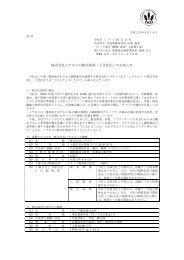Annual Report 2012
Annual Report 2012
Annual Report 2012
Create successful ePaper yourself
Turn your PDF publications into a flip-book with our unique Google optimized e-Paper software.
Notes to Consolidated Financial Statements<br />
1. Basis of Presenting Consolidated Financial Statements<br />
The financial statements of Nipro Corporation (“the Company”)<br />
and its consolidated domestic subsidiaries have been prepared in<br />
accordance with the provisions set forth in the Financial Instruments<br />
and Exchange law of Japan and its related accounting regulations,<br />
and in conformity with accounting principles generally accepted in<br />
Japan, which are different in certain respects as to application and<br />
disclosure requirements of International Financial <strong>Report</strong>ing Standards.<br />
Effective from the year ended March 31, 2009, the Company has<br />
adopted the “Practical Solution on Unification of Accounting Policies<br />
Applied to Foreign Subsidiaries for Consolidated Financial Statements”<br />
(PITF No. 18) and as a result, the accounts of consolidated overseas<br />
subsidiaries are prepared in accordance with either International<br />
Financial <strong>Report</strong>ing Standards or generally accepted accounting<br />
principles in the United States, with adjustments for the specified five<br />
items as applicable.<br />
2. Summary of Significant Accounting Policies<br />
(a) Basis of Consolidation<br />
The consolidated financial statements include the accounts of the<br />
Company and the significant subsidiaries and affiliated company<br />
accounted for by the equity method.<br />
Investments in unconsolidated subsidiaries are stated at cost and<br />
the equity method is not applied for the valuation of such investments<br />
since they are considered immaterial in the aggregate.<br />
All significant intercompany balances and transactions have been<br />
eliminated in consolidation. All material unrealized profit included<br />
in assets resulting from transactions within the Company and its<br />
consolidated subsidiaries is eliminated. The difference between the<br />
cost of investments in subsidiaries and affiliates and the equity in their<br />
net assets at dates of acquisition is being amortized on a straight-line<br />
basis over five to ten years.<br />
All accounts herein have been presented on the basis of the twelve<br />
months ended March 31, <strong>2012</strong> for the Company and for consolidated<br />
domestic subsidiaries, and December 31, 2011 for all consolidated<br />
overseas subsidiaries.<br />
Adjustments have been made for any significant intercompany<br />
transactions which took place during the period between the end of<br />
accounting period of the consolidated overseas subsidiaries and that<br />
of the Company.<br />
(b) Translation of Foreign Currencies<br />
Balance sheets of consolidated overseas subsidiaries are translated<br />
into Japanese yen at the current exchange rate as of the balance<br />
sheet date except for shareholders’ equity, which is translated at<br />
the historical rate. Income statements of consolidated overseas<br />
subsidiaries are translated into Japanese yen at the average exchange<br />
rate for the period. Resulting translation adjustments are shown as<br />
“Foreign currency translation adjustments” in the “Accumulated other<br />
comprehensive income” section of net assets.<br />
In preparing the accompanying consolidated financial statements,<br />
certain reclassifications have been made to the consolidated<br />
financial statements issued domestically, in order to present them<br />
in a form which is more familiar to readers outside Japan. However,<br />
no adjustment has been made which would change the financial<br />
position or the results of operations presented in the original financial<br />
statements. In addition, the notes to consolidated financial statements<br />
include additional information which is not required under generally<br />
accepted accounting principles and practices in Japan.<br />
The financial statements presented herein are expressed in<br />
Japanese yen and, solely for the convenience of the reader, have been<br />
translated into United States dollars at the rate of ¥82.19=US$1, the<br />
approximate exchange rate on March 31, <strong>2012</strong>. These translations<br />
should not be construed as representations that the Japanese yen<br />
amounts actually are, have been or could be converted into U.S.<br />
dollar amounts.<br />
(c) Cash and Cash Equivalents<br />
Cash and cash equivalents include all highly liquid investments,<br />
generally with original maturities of three months or less, that are<br />
readily convertible to cash.<br />
(d) Inventories<br />
Inventories are stated principally at cost, carrying amount in the<br />
balance sheet is calculated with consideration of written downs due<br />
to the decreased profitability. Cost is determined principally by the<br />
average method, except for certain inventories determined by the<br />
first-in, first-out method.<br />
(e) Depreciation<br />
Depreciation of property, plant and equipment of the Company and<br />
its consolidated domestic subsidiaries is computed principally by<br />
the declining-balance method. The straight-line method is applied to<br />
buildings acquired by the domestic companies after April 1, 1998,<br />
and is principally applied to the property, plant and equipment of<br />
consolidated overseas subsidiaries.<br />
The range of useful lives is principally from 31 to 50 years for<br />
buildings and from 7 to 8 years for machinery and equipment.<br />
Nipro Corporation <strong>Annual</strong> <strong>Report</strong> <strong>2012</strong> 34




